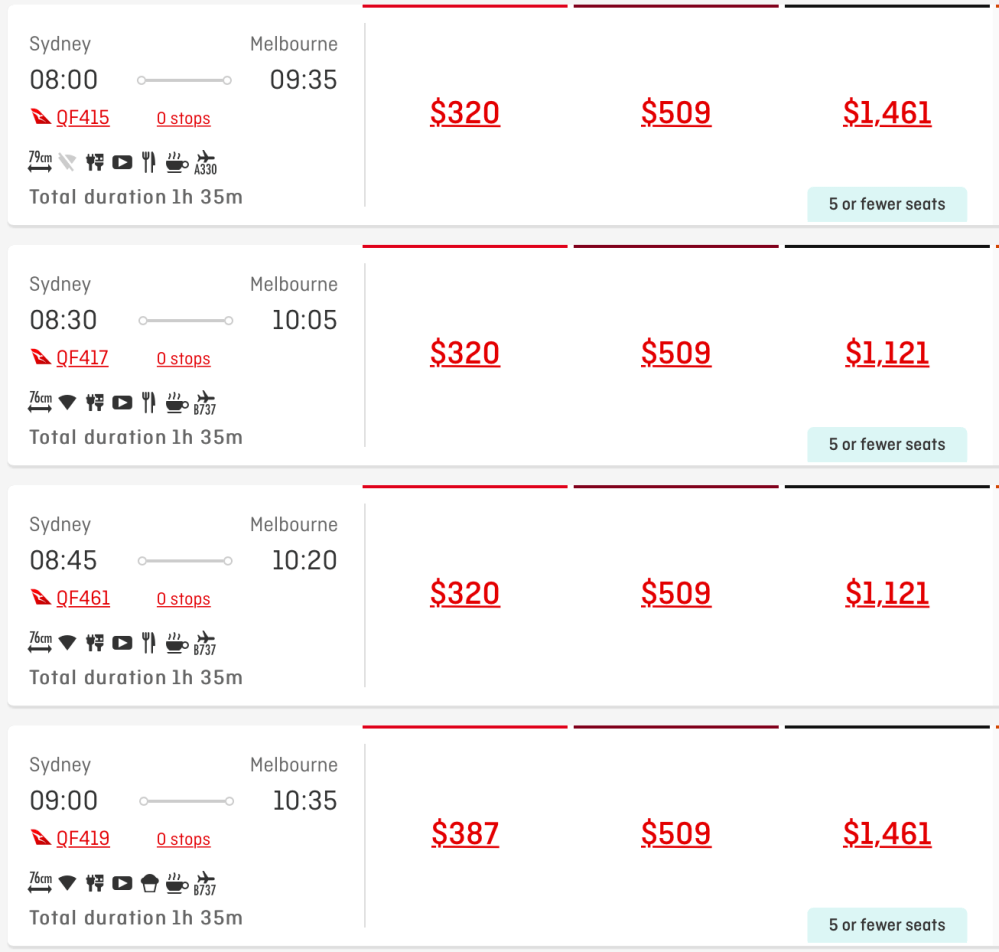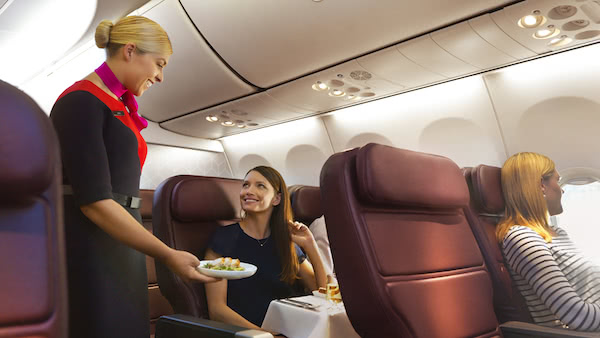A university professor of mine once said that the answer to every question is, ‘it depends’, a statement that really encompasses whether or not flying business class on a short-haul domestic route is ever really worth it.
There’s a lot of talk about the latest long-haul Business products to grace the skies, with enclosed suites and double-beds now the norm. Competition is inevitably fierce and consumers are growing pickier by the season trying to weed out the best long-haul offerings. The short haul, though is often neglected. We don’t talk about domestic Business Class, and most people think that anyone who pays for it is insane. The bulk of highly-frequent business travellers (those who provide the most financial value to the airlines) tend to hop up and down on ‘bus-routes’ that are typically less than 2 hours in length and feature flights every 30 minutes – take Sydney-Melbourne for example.
Red-e-Deal Flex Business
The above is a sample of the fare offerings on a typical Monday morning. Business Class peaks at $1461 for a flight that lasts 1h 35m, and almost every one of these flights will operate with an 80%+ load factor in this cabin. These flights are almost always operated by a Boeing 737, which Qantas flies with a very basic recliner seat in Business Class:

Onboard there will typically be a rapid meal service (not with tablecloths laid out and hand delivered plates as pictured) followed by an immediate descent, given the short flight duration. So why should you ever pay such a steep price for such a short and simple product? Well, it depends.
The ground experience
This is where the benefits of an ultra-short-haul Business product are really reaped. Unlike your tightly timed onboard experience, the lounge is yours to use for any amount of time on the day of your departure and this is more valuable than may be thought. Picture flying from Sydney to Melbourne in the early morning, grabbing breakfast and a shower after arrival and heading into the city for meetings, interviews or whatever else. Heading back to the airport for your evening flight back, your friend or colleague is keen for a drink so you take them along to the lounge as your guest (they need not be flying anywhere), enjoy a meal and maybe even squeeze in a meeting if needed, before it’s back onboard. Whilst Virgin Australia delivers a relatively average lounge experience, Qantas’ new Business and Club lounges are phenomenally designed, with well-thought-out décor and useful features such as meeting rooms and showers.

Be it a meeting, coffee catch-up or even date-night, the lounge can really be the source of value for a short domestic trip, justifying the premium price. Note that, of course, this is irrelevant if you already hold a valid frequent flyer membership or lounge access subscription.
Frequent flyer redemptions
Within the domestic network, particularly along the East Coast triangle (SYD-MEL-BNE), redemptions are pretty lucrative. Qantas and Virgin Australia charge similar rates for these journeys with Qantas requesting just 8,000 points for Economy and 16,000 for Business on a one-way trip. Considering commercial Business fares reach as high as $1,400, frequent flyer redemptions yield a whopping 8.75 cents/mile value making this of particular interest, especially given available award seats are usually easy to come by. For not much at all, keen travellers, holidaymakers looking for something a little more or business travellers with a healthy balance of points can make use of a truly premium experience.
‘The company pays’
Of course, this is the straight forward one, and in fact the most common. Many major corporations have tightened corporate travel policies to restrict Business Class travel to medium-long-haul sectors (typically beyond 5-8 hours in length). However, several still continue to permit their staff to use Business Class on even the shortest domestic routes, with certain ranked employees of course only ever travelling in the premium cabins. In these circumstances with highly inelastic demand, price rarely matters. The premium service and product is delivered so the customer is happy; the employee is happy meaning the company is happy; and the airline is even happier because someone just spent the equivalent of a Business Class trip to Singapore on a 1.5 hour flight to Melbourne. That, in short, is really how airlines manage to cross over the fence from loss to profit.
A truly superior product
Once in a while (maybe 1-2 times a day) Qantas and Virgin operate their ‘flagship’ A330s on the busy triangle sectors. These aircraft are fitted with fully flat beds in Business (not that anyone really needs it on such a short jaunt) further justifying why it may be worth paying extra. It sweetens the deal, particularly if wanting to make your journey special or if needing to maximise productivity.

International connections
This is a slightly different one as it is more a matter of, ‘why should the airline even offer Business Class on this route?’ Many people travelling on domestic sectors are connecting to or from a longer international flight. Managing DOM-INT or INT-DOM connections well can make or break a customer’s journey, which is of particular concern to the airline given the total-journey-lengths that the passengers are being carried. An individual booking a flight from Los Angeles to Adelaide via Sydney in Business Class expects that product to be delivered the entire way through. Imagine coming off a flat-bed, long-haul Business product on an A380, only to be shoved into a middle seat in Economy for the last part of your journey, after paying for a Business fare. It’s both unpleasant and blatantly inconsistent. The customer’s long haul Business Class fare would be exactly the same regardless of whether or not the final domestic sector had a Business cabin fitted, meaning they would in effect be given an Economy product for a Business price. Whilst the hard product is of course non-consistent, it is vital that a consistent soft-product (i.e. the service) is provided on such journeys. Customers still need a premium product throughout their journey, even if it is just Economy with a blocked middle seat – as in Europe:

The opposite end of this is Singapore Airlines who offer a flat bed, long-haul-suitable product on even the shortest routes (take the 45 minute flight to Kuala Lumpur for example). This takes consistency to a whole new level, a primary and immediate goal for the carrier.
So short-haul Business Class is not all that much of a taboo. Many look at it and think “why would anyone in their right mind pay so much for so little?” Well, as explained, there are a number of reasons. The superior and valuable ground experience; a lucrative frequent flyer redemption; the company travel policy; better hard products; and internationally connecting passengers are just a few of the reasons why people pay up to four times more for a slightly larger leather seat. It of course all boils down to what you value, too. Unless your trip is paid for by someone else, it’s a matter of: who are you; and why are you travelling? If you’re a couple on a special trip, then why not make the most of it? If you’re an aviation-geek who loves flying why not experience something you might otherwise be unable to? If you’re restricted with time and are doing a day trip, why not make it just a little easier? There are many reasons why (and why not), so don’t hate on domestic business!
